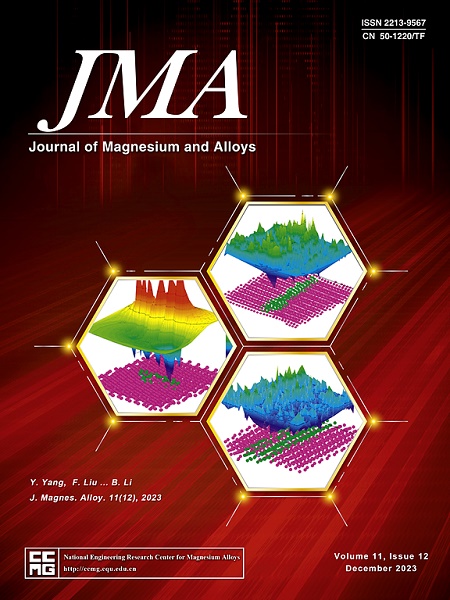搅拌摩擦法制备Mg-Zn-Nd-Zr/HA复合材料的体外降解和体内成骨研究
IF 15.8
1区 材料科学
Q1 METALLURGY & METALLURGICAL ENGINEERING
引用次数: 0
摘要
添加羟基磷灰石(HA)等类骨化合物的可生物降解镁基复合材料(BMMCs)具有良好的骨科应用潜力,但BMMCs在体内的研究结果不足,体外和体内的差异尚不清楚。采用摩擦搅拌工艺(FSP)制备了Mg-Zn-Nd-Zr/(10/15/20wt%) HA (Ca10(PO4)6OH2)复合材料。结果表明,复合材料的腐蚀速率随HA含量的增加而增加,其中Mg/10wt% HA的析氢腐蚀速率约为0.107 mm/y,与其他bmmc相比具有更好的耐蚀性,HA粉末的团聚明显加剧了局部腐蚀。Mg/10wt% HA (2.12 IU/ Mg)培养14 d后,MC3T3-E1细胞ALP特异性活性高于基质(1.85 IU/ Mg),但与FSP组(2.13 IU/ Mg)无显著差异。兔股骨植入早期,Mg/10wt% HA的骨体积分数(BV/TV)为10.69,高于FSP组(6.35)。组织学染色显示,Mg/10wt% HA植入物被更多的骨小梁组织包围,表现出更好的骨诱导再生。Mg-Zn-Nd-Zr/HA复合材料在体内表现出更高的成骨活性,与体外成骨表达不同。本文章由计算机程序翻译,如有差异,请以英文原文为准。
In vitro degradation and in vivo osteogenesis of Mg-Zn-Nd-Zr/HA composites prepared by friction stir processing
Biodegradable magnesium-matrix composites (BMMCs) added with bone-like compounds such as hydroxyapatite (HA) have promising orthopedic application potential, but the in vivo results of BMMCs are insufficient, and the difference between in vitro and in vivo are not clarified. In this work, Mg-Zn-Nd-Zr/(10/15/20wt%) HA (Ca10(PO4)6OH2) composites were prepared through friction stirring processing (FSP). It was found that corrosion rate of the composites increased with increase of the HA content, where the corrosion rate from hydrogen evolution of the Mg/10wt% HA was about 0.107 mm/y, showing better corrosion resistance compared with other BMMCs, and the agglomeration of HA powders significantly aggravated the localized corrosion. The ALP specific activity of the MC3T3-E1 cells cultured for 14 days with Mg/10wt% HA (2.12 IU/mg) was higher than that of the matrix (1.85 IU/mg), but there was no difference with the FSP group (2.13 IU/mg). In the early implantation of the rabbit femur, bone volume fraction (BV/TV) of Mg/10wt% HA was 10.69, which was higher than that of the FSP group (6.35). The histological staining showed that the Mg/10wt% HA implant was surrounded by more trabecular bone tissue, exhibiting better osteoinductive regeneration. The Mg-Zn-Nd-Zr/HA composites exhibit higher osteogenic activity in vivo differently from in vitro osteogenic expression.
求助全文
通过发布文献求助,成功后即可免费获取论文全文。
去求助
来源期刊

Journal of Magnesium and Alloys
Engineering-Mechanics of Materials
CiteScore
20.20
自引率
14.80%
发文量
52
审稿时长
59 days
期刊介绍:
The Journal of Magnesium and Alloys serves as a global platform for both theoretical and experimental studies in magnesium science and engineering. It welcomes submissions investigating various scientific and engineering factors impacting the metallurgy, processing, microstructure, properties, and applications of magnesium and alloys. The journal covers all aspects of magnesium and alloy research, including raw materials, alloy casting, extrusion and deformation, corrosion and surface treatment, joining and machining, simulation and modeling, microstructure evolution and mechanical properties, new alloy development, magnesium-based composites, bio-materials and energy materials, applications, and recycling.
 求助内容:
求助内容: 应助结果提醒方式:
应助结果提醒方式:


